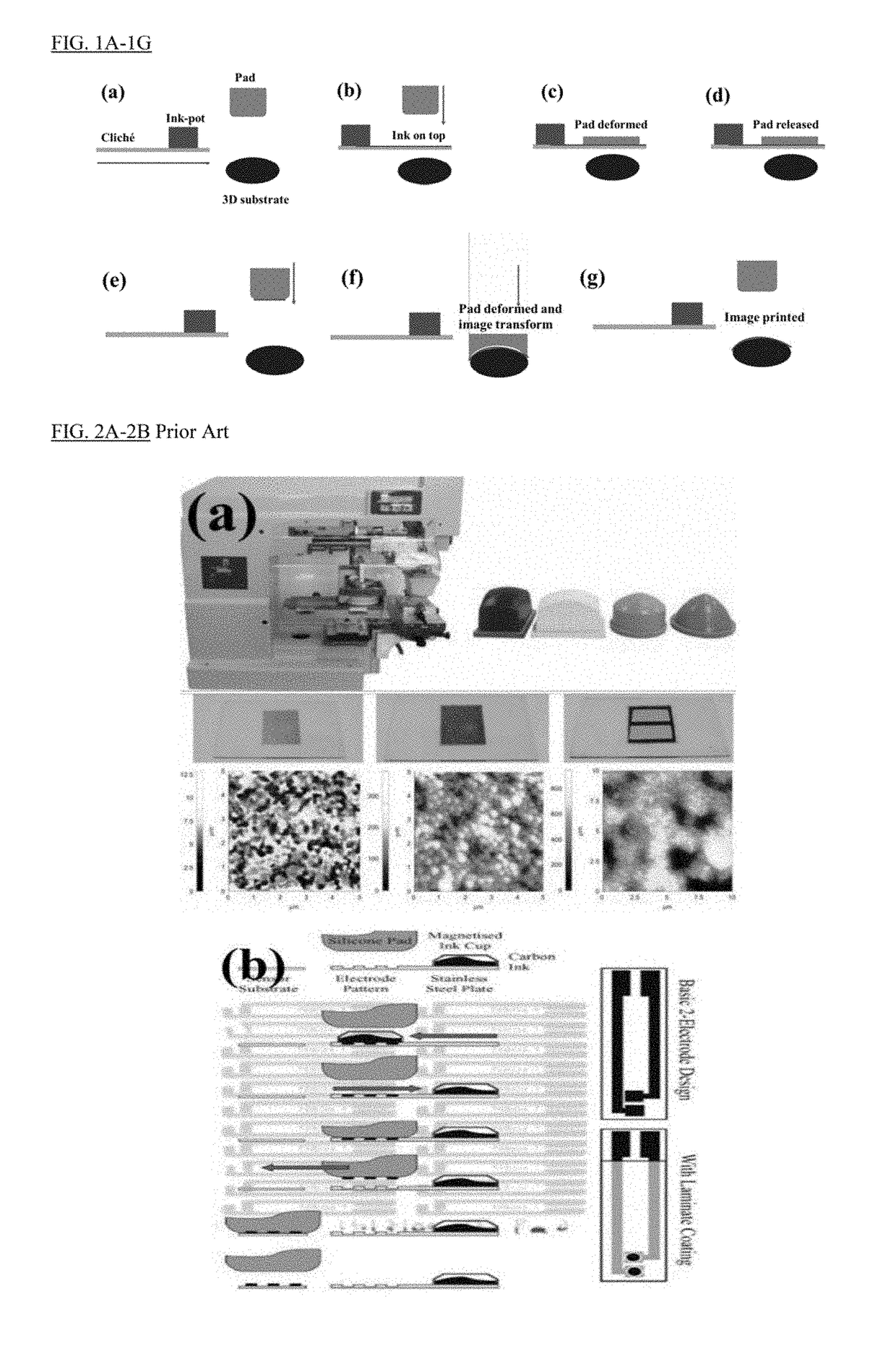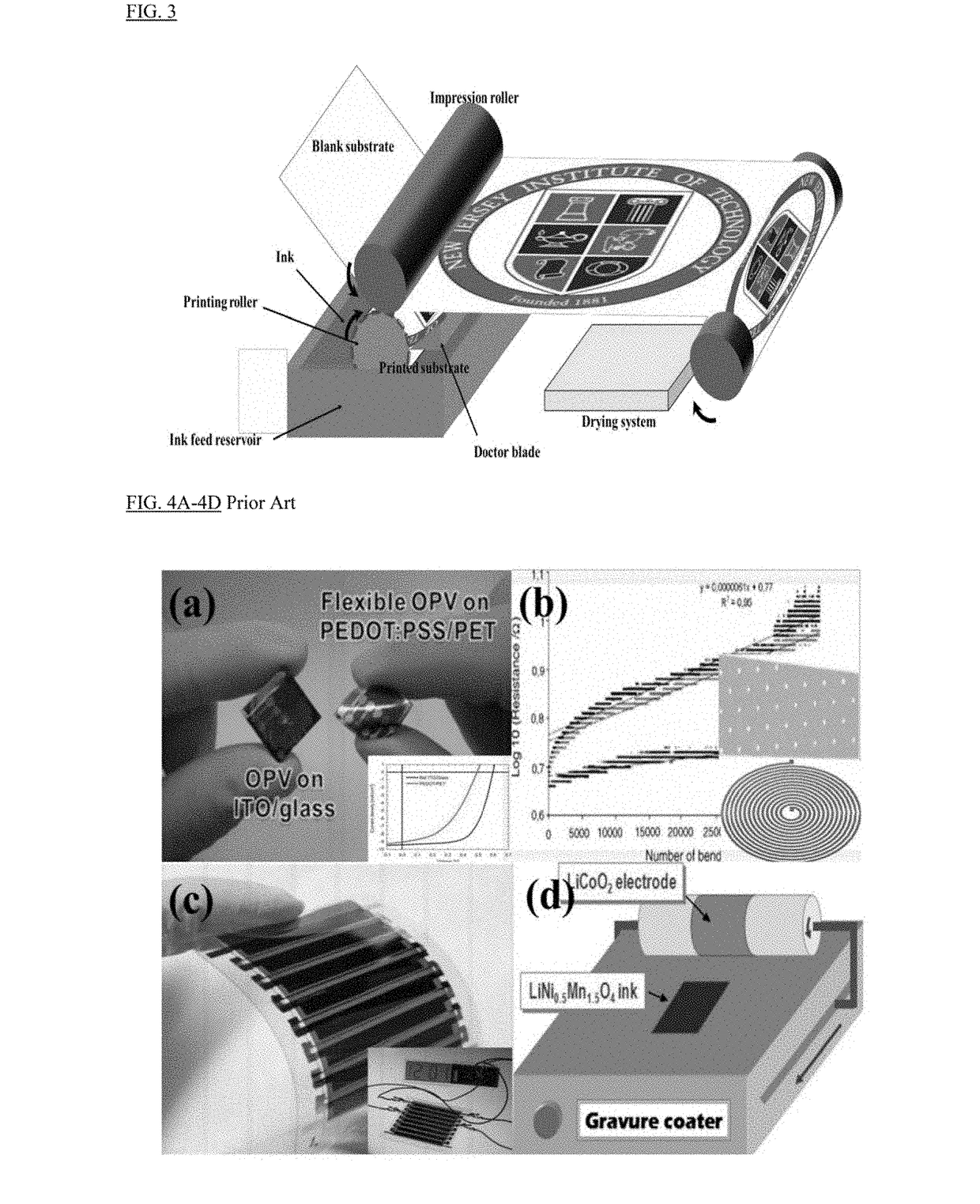Fabrication of flexible conductive items and batteries using modified inks
a technology of flexible conductive items and batteries, applied in the field of inks and printing technology, to achieve the effect of less porosity, high resolution printing, and reduced resistivity of silver patterns made by chemical reduction
- Summary
- Abstract
- Description
- Claims
- Application Information
AI Technical Summary
Benefits of technology
Problems solved by technology
Method used
Image
Examples
example 1
Results
[0171]Effect of NaCMC Surfactant
[0172]The effect of NaCMC surfactant on silver film fabrication is studied. CMC was found to be a very effective water soluble polymer stabilizer against aggregation. The main principle is negative charged carboxyl radicals (—COO—) in NaCMC solution bind on the positive charged metallic particles, the attached polymer layer can provide a strong electrostatic or steric repulsions to cancel the attractive van der Waals to prevent agglomeration.
[0173]FIG. 32 shows the SEM images of silver film made by thermal decomposition without NaCMC and thermal decomposition with NaCMC at different magnifications. The particle size is not uniform without NaCMC additive from FIG. 33A-33B. Also the large particles are not sintered very well. The silver film becomes more uniform after adding NaCMC from FIG. 33C-33D. This can be explained by Ostwald ripening process which occurs in drying process without NaCMC additive. Small silver citrate crystals dissolve, and ...
example 2
Results
[0203]CRS Process Research
[0204]The measured pH value change of the ink during fabrication is shown in FIG. 45. The pH value of constantan / water / PVP dispersed is around 7.60 in process 1. In process 2, there is no significant pH change after adding ammonia chloride (NH4Cl) into the constantan suspension. This confirms the formation of copper / nickel ammonia complex, because NH4Cl solution is acidic if no copper / nickel ammonia complex is formed. The pH value drops down a little after adding TD into the suspension in process 3.
[0205]Surprisingly the pH value remains the same after adding KOH into the suspension which suggests chemical reaction between TD and KOH at room temperature is:
(NH2)2CSO2+2KOH═(NH2)2CO+K2SO2+H2O Equation 5.
[0206]Adding KOH has no effect on pH value according to Equation (5). The high chemical active SO22− released from Equation (5) (marked red in FIG. 45) can reduce copper / nickel ammonia complex at high temperature in basic environment as in Equation (6)...
example 3
[0233]Nickel Part
[0234]FIG. 57A-57B shows the XRD patterns of nickel powder before and after sintering. All of them show at 2θ of 44.5°, 51.8° and 76.4° index as (111), (200) and (220) (JCPDS file No. 04-0783) reflections of the Fm-3m space group without any significant impurities. Usually, nickel is oxidized in air and surrounded by a thin and dense oxidation. This phenomenon is similar with aluminum. However, no oxidation is detected from XRD results indicating that this oxidation layer is too thin to be detected. This oxidation layer is very dense and has very tight chemical connect with the nickel bulk to prevent further oxidation, which would be a barrier among the particles during sintering. The thin oxidation layer cannot provide enough nickel ions which play an important role during CRS process; additional external nickel ions are needed. After the CRS process, no impurities remains in the nickel patterns, with extra chloride and ammonia ions completely evaporated. The posit...
PUM
| Property | Measurement | Unit |
|---|---|---|
| temperature | aaaaa | aaaaa |
| melting temperature | aaaaa | aaaaa |
| resistivity | aaaaa | aaaaa |
Abstract
Description
Claims
Application Information
 Login to View More
Login to View More - R&D
- Intellectual Property
- Life Sciences
- Materials
- Tech Scout
- Unparalleled Data Quality
- Higher Quality Content
- 60% Fewer Hallucinations
Browse by: Latest US Patents, China's latest patents, Technical Efficacy Thesaurus, Application Domain, Technology Topic, Popular Technical Reports.
© 2025 PatSnap. All rights reserved.Legal|Privacy policy|Modern Slavery Act Transparency Statement|Sitemap|About US| Contact US: help@patsnap.com



